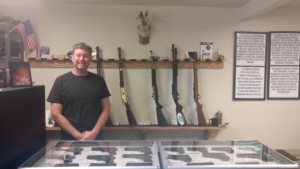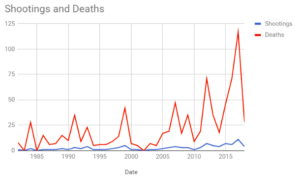In 1994, Matthew Blek was a 21-year-old math and physics major on a summer trip to New York. Walking a date home one evening, Blek was jumped by three 15-year-olds, one of which was armed with a .32 caliber pistol. Blek offered no resistance to the robbery, complying with their demands, but was shot and killed. He was their second victim of the evening.
Instead of falling into defeat, Matthews father, Charlie Blek and his wife were inspired. They entrenched themselves in the battle to stop gun violence. Blek, now the president of the Orange County chapter of the Brady Campaign to Prevent Gun Violence, described the incident as his “unceremonious recruitment” into the gun control fight.
From small scale violence to mass shootings, Americans like Blek’s son must live in constant fear of becoming the next in a rapidly growing list of gun violence victims. Though the majority agree there is a problem, those on either side of the aisle disagree with how to solve it. In addition, organizations like the NRA that have contributed millions of dollars to keeping laws the way they are are one of the biggest obstacles to gun reform.
The goal of the Brady Campaign is to cut the number of gun deaths in the United States in half by 2025, by using a strategy focused around responsible gun ownership and keeping guns out of the hands of the wrong people, according to their website.
One piece of legislature which Blek said can help realize this goal in the Gun Violence Restraining Order Act, which allows court orders to be issued to remove a person’s gun until a later court date, usually around 21 days, or up to a year if a judge sees fit. Under current California law, family members of gun owners and law enforcement can file to have a gun restrained. Five states have enacted similar gun violence prevention laws since 1999.
Most recently, assemblyman Phil Ting of San Francisco proposed expanding the bill to add “employers, co-workers, high school and college staff, and mental health workers to the list of individuals who can seek a restraining order,” The Sacramento Bee reported in February.
“The philosophy behind the bill is simple: you can always return a gun, but you can’t return a life.” Blek said.
Estimates of the number of guns in the U.S. vary. The Washington Post reported in October 2015 that the number of guns surpassed the number of people around 2009, and Vox released a similar report less than a year later. The Congressional Research Service estimates there are about 300 million guns. That amounts to about one gun per person,
About 50 percent of total guns in the United States are owned by just three percent of the population, according to The Guardian.
Blek said the Parkland shooting as an example of the need for strict gun reform, pointing out several pieces of legislation that exist in California that would have reduced the impact of the shooting.
“One, we have banned assault weapons. Two, we have reduced the size of magazines to no more than 10 bullets. Three, we have universal background checks. Four, we have an armed and prohibited persons list, which removes guns from those who have become a prohibited person,” he said.
In California, an assault rifle is any semi-automatic rifle with a detachable magazine and any one of: a pistol grip, thumbhole stock, folding or telescoping stock, a grenade or flare launcher, flash suppressor, or a forward pistol grip. Fixed magazine weapons may have some of these, though can accept no more than 10 rounds, and must be longer than 30 inches. Though one common loophole is to attach a “bullet button” to the gun, which legally classifies it as a fixed magazine, but can be removed by inserting a bullet into the mechanism.
“When we tolerate that size of a magazine, we’re only sanctioning the hunting of other human beings,” Blek said.
The owner of local gun store Ed’s Gun Sales, Ed Roth, agrees that there is a problem with mass shootings and gun violence though he is a gun enthusiast. He said private sellers shouldn’t be able to make sales without background checks, no matter the circumstance. When guns are used for crime, Roth said it casts legitimate vendors like him in a poor light.
“You just don’t know if you’re selling to someone who’s mentally ill or a felon [when sales are made privately],” he said.

However, Roth sees it as a cultural problem with violence, and that guns are just the easy, go-to weapon. He said violent video games and movies have led to desensitization of younger people, and that many kids looking to act out grab a gun because it is what they see in movies and on TV. In addition, he blames media sensationalization of the shooter’s identity for inspiring future shooters.
“I’ve met 10 year olds who know more about some military grade guns than I do, because these games teach them all about it,” Roth said. “Working as a nurse, I’ve seen people cut open, intestines showing, brain cut open, limbs cut off, and I’ve become desensitized to it. These games do the same thing.”
When it comes to assault rifles, shop owner Ed Roth disagrees that they should be abolished entirely, but the process by which people purchase assault rifles could change.
“It would be great if everyone could own whatever they wanted, but some people aren’t responsible enough to handle fully automatic weapons, just like not everyone is responsible enough to own a 180 mph car,” Roth said.
Blek called the NRA the biggest obstacle to gun reform, and believes some Americans have become scared of “big brother taking their guns,” a notion he considers not only unreasonable, but impossible. To combat this, Blek says that organizations like Brady work on a grassroots level to work legislation through local and state government, eventually expanding it to the federal level.
“The NRA has fought us every single step of the way because the gun manufacturers have taken over its board, not it’s membership, and they are more interested in making money than in the goodwill and safety of our citizens,” Blek said
The NRA alone spends more on lobbying than all of the interest groups related to gun control combined. The NRA spent about $5.1 million in lobbying in 2017 while the National Shooting Sports Foundation spent $3.3 million, according to the Center for Responsive Politics.
By contrast, the largest lobbying spender on the gun control side, Everytown for Gun Safety, spent $1.3 million on lobbying, with the Giffords PAC coming in second at $510,000. The Giffords PAC, founded by democratic senator Gabrielle Giffords, is the only major campaign contributor on the gun control side, contributing only $36,500 in 2017-2018 compared to the NRA’s $309,168.
An NRA representative could not be reached for comment.
In our current gun climate, preparing for a mass shooter is something school and universities are approaching with detailed action plans.
According to Chief of Public Safety Randy Burba, Public Safety regularly trains with the Orange Police Department to reduce the response time to the school. They use the Panther Alert system to inform students of any possible incidents, and have camera systems that they can broadcast to OPD, as well as schematics and keys to give them full access to buildings in case of an incident.
“We have tabletop exercises and full scale exercises to help condense the response time, because that is the number one factor,” Burba said.
Burba said that the chance of a shooting occurring on Chapman’s campus is immeasurably small, so students should be prepared, but shouldn’t be worrying about it day-to-day.
Orel Shilon, a freshman business major, said she feels secure on campus, and doesn’t invest much energy into politics.
“I only really think about [gun violence] when it’s in the news, mostly because I feel that Chapman is so safe,” said Shilon. “Just based on how much it still happens, [politicians] haven’t done a very good job at solving the issue.”
In the case of an incident, Burba says that students should “run, hide, or fight.” He recommends that students familiarize themselves with alternate routes to and from classes, as well as survey their classes for hiding places in case of a threat.

A chart showing the rise of deaths and frequency of mass shootings from 1982-2018. Data from 2018 Mother Jones investigation, graph by Blake Waddell.
